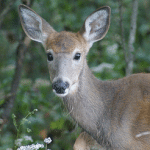
With this comes significant danger to drivers. During this time, deer become very active and unpredictable, covering large areas in search of a mate. A result of this is that drivers will often see groups of deer crossing roads.
This generates tens of thousands of deer-vehicle crashes every year, resulting in millions of dollars in damage. To help prevent this happening to you, please review the tips below:
- If you spot a deer, slow down and pay attention to possible sudden movement. If the deer doesn’t move, don’t go around it. Wait for the deer to pass and the road is clear.
- Pay attention to “Deer Crossing” signs. They are there for a reason. Slow down when traveling through areas known to have a high concentration of deer so you will have ample time to stop if necessary.
- If you are traveling after dark, use high beams when there is no oncoming traffic. High beams will be reflected by the eyes of deer on or near roads.
- If you see one deer, be on guard: others may be in the area. Deer typically move in family groups at this time of year and cross roads single-file.
- Don’t tailgate. Remember: the driver in front of you might have to stop suddenly to avoid hitting a deer.
- Always wear a seatbelt, as required by law. Drive at a safe and sensible speed, taking into account weather, available lighting, traffic, curves and other road conditions.
- If a collision appears inevitable, do not swerve to avoid impact. The deer may counter-maneuver suddenly. Brake firmly, but stay in your lane. Collisions are more likely to become fatal when a driver swerves to avoid a deer and instead collides with oncoming traffic or a fixed structure along the road.
- Report any deer-vehicle collision to a local law enforcement agency immediately.
Latest posts by California Casualty (see all)
- California Casualty Earns Financial Stability Rating® of A, Exceptional, From Demotech, Inc. - April 28, 2025
- Music & Arts Grant Recipients – 2024 - December 13, 2024
- Understanding Auto and Home Insurance Rate Changes - December 3, 2024
